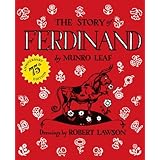
Book Summary:
Ferdinand was never interested in normal things that bulls like to do, such as playing with the other bulls. He would always rather sit quietly and smell the flowers. When five men come to the farm to pick the biggest toughest bull to take to Madrid for the bullfights the other bulls spent time showing off, hoping to be the one chosen to be in the bullfights in Madrid, but not Ferdinand. He went to his favorite tree to sit and smell the flowers. Ferdinand sat on a bee and when his reaction to the bee sting was him running and jumping around, he was chosen by the five men to be the bull that would be in the bull fights in Madrid. Once Ferdinand was in the bull ring in Madrid he didn't stomp or run or act like a bull. He sat down in the middle of the ring to smell all the flowers in the ladies hair. He wouldn't fight no matter how much they tried, so Ferdinand got to return to the farm and his favorite tree to smell the flowers.
APA Reference of the Book:
Leaf, M. (1936). The story of Ferdinand. New York, NY: The Viking Press.
Impressions:
The lesson that the reader learns from this book is priceless. Don't do what everyone else is doing just because that is what we are supposed to do. Do what makes you happy. At first look, the illustrations were good, but they would have been more impressive if they were in color instead of black and white. After reading the story, I actually thought that the illustrations were perfect for the book. The pictures were well done, and they fit the story very well without being distracting and overpowering the story. This book also gives the reader some insight into the bull fights of Madrid, which may be one of the first instances that these children are exposed to this event within the Spanish culture. It is rare to find a story with such a great lesson and exposes the reader to aspects of a different culture, especially for this age group. The plot was well written and the pace was fast enough to keep the children's attention.
Professional Review:
Full Text:
Leaf, Munro. El cuento de Ferdinando. (The Story of Ferdinand) tr: by Pura Belpre. illus. by Robert Lawson. New York: Viking Press. (Puffin Storytape) 1988, c1962. 68p. ISBN 0-140-54253-1 (sound cassette and book). $12.95.
A lively, simple, and playful translation makes this classic story of the misunderstood bull who'd rather smell flowers than stomp and snort an all-time favorite for sharing in Spanish as well as in English. Also published by Scholastic in 1990.
Gonzalez, L. (2001, August). The story of Ferndinand.Library Journal, 126(13), S27. Retrieved from http://lj.libraryjournal.com/
Library Uses:
Leaf, Munro. El cuento de Ferdinando. (The Story of Ferdinand) tr: by Pura Belpre. illus. by Robert Lawson. New York: Viking Press. (Puffin Storytape) 1988, c1962. 68p. ISBN 0-140-54253-1 (sound cassette and book). $12.95.
A lively, simple, and playful translation makes this classic story of the misunderstood bull who'd rather smell flowers than stomp and snort an all-time favorite for sharing in Spanish as well as in English. Also published by Scholastic in 1990.
Gonzalez, L. (2001, August). The story of Ferndinand.Library Journal, 126(13), S27. Retrieved from http://lj.libraryjournal.com/
This book would be great to use in a cultural study at the library, or an all around the world series at the library. This book would be great to read to the children during a unit on Spain. Prepare a Spanish treat for a snack. For a craft have the children color a flower print out, then have them attach a cotton ball, which has been previously sprayed with a lavender scented body spray, to the center of the flower.
